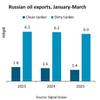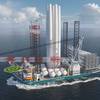Nordic American Tanker Q2 2010 Report
Nordic American Tanker Shipping Ltd. (NAT) announced that the dividend for 2Q10 was $0.60 per share which is the same as for 1Q10. At a time when several shipping companies produce negative results, the Board of Directors is pleased to announce that NAT turned in a solid net income in 2Q10.
NAT expect that the company’s fleet will reach a minimum of 20 vessels by the end of 2011. NAT has no plans to tap the equity markets to fund this expansion, since the company currently has ample financial resources to reach a fleet of 24 vessels.
The company will pay the dividend on or about September 2, 2010, to shareholders of record as of August 20, 2010. Since the autumn of 1997, when the company's first three vessels were delivered, NAT has always paid a quarterly dividend; the total dividends paid through the second quarter of 2010 amount to $41.34 per share.
The Key points:
* A dividend of $0.60 per share has been declared for 2Q10 - the same as for 1Q10. Earnings per share in 2Q10 were $0.17 as compared to $0.21 in 1Q10.
* In April, 2010, NAT entered into an agreement with Samsung Heavy Industries Co., Ltd, to build two suezmax tankers of 158,000 dwt each to be delivered in the third and fourth quarters of 2011. The purchase price for the two vessels is in aggregate $129.5m. Generally, the values of newbuildings have risen somewhat since NAT signed its agreement with Samsung Heavy Industries Co., Ltd.
* The company consolidated its commercial operations during the second quarter. Our vessels that are traded in the spot market are now in the Gemini suezmax cooperative arrangement. Of the 16 vessels that our company currently operates, 15 are in the spot market.
* The company has no net debt and does not engage in any type of derivatives.
* So far in 3Q10, the spot tanker market is lower than in 2Q10.
Fleet Expansion and Accretion:
During 2Q10, NAT has seen some appreciation of asset values in the secondhand market for vessels. Initial Public Offerings (IPOs) have contributed to this development, which is now abating. Investors have become more discerning about the quality of shipping companies in which they invest.
NAT are in a good position to take advantage of strong shipping markets, which will mean increased dividend payouts. If markets are weak, NAT will be ideally positioned to grow its fleet assertively.
During 2009, NAT agreed to acquire four vessels which have been delivered to the company. As indicated above, the fleet is expected to stand at a minimum of 20 vessels late in 2011.
The expansion of the company has improved its position relative to that of some of our competitors who have had a difficult time coping with the consequences of the international financial crisis.
Dividend Capacity:
At present ship values, the company has ample financial capacity to increase its fleet to 24 vessels without tapping the equity market.
The company will continue to keep a strong balance sheet with no or little net debt. However, in a weaker market environment the company is prepared to add some debt to the balance sheet, assuming a slightly higher financial risk. This does not imply any change in the strategy of the company and non-retiring debt continues to be an integral part of the business model of Nordic American.
With all but one vessel (the Gulf Scandic which will be redelivered in November 2010) operating in the spot market, the company is in a position to reap the benefits of a potential upswing in the tanker market.
Below is a chart indicating the annual dividend capacity based on a fleet of 20 vessels and 24 vessels at different spot market rates.
The above is based on 355 income days per vessel per year. The net debt is about $7m per vessel with a cash break-even level of $11,300 per day per vessel for a 20 vessel fleet. The same numbers for a 24 vessel fleet are $16m per vessel and $12,300 per day per vessel. The numbers show the substantial dividend capacity of NAT.
When the freight market is above the cash break-even level, the company can be expected to pay a dividend. The breakeven rate is the amount of average daily revenues our vessels would need to earn in the spot market in order to cover vessel operating expenses, voyage expenses, if any, cash general and administrative expenses, interest expense and other financial charges.
The annual spot rates as reported by R.S. Platou Economic Research A.S. show that during the last 10 years up to the end of 2009, seven years have produced about $40,000 on average per day per ship or better.
Typically, our dividend correlates with the suezmax spot freight rates. Going forward, NAT can expect that spot suezmax freight rates may fluctuate in an unpredictable manner.
The lack of commercial bank financing and higher margins on shipping loans are challenging for debt-laden shipping companies. By having no or little net debt, NAT is better positioned to navigate the financial seas, as NAT believe that is in the best interests of our shareholders.
NAT’s primary objective is to maximize total return to shareholders, including maximizing our quarterly cash dividend.
The company has further acquisitions under evaluation and will work to continue to strengthen its position compared with that of its competitors.
Financial Information
The Board has declared a dividend of $0.60 per share in respect of 2Q10 to
shareholders of record as of August 20, 2010. Because of the strong financial
position of the Company, it is appropriate that shareholders at this time
receive an extra $0.10 above the dividend of $0.50 per share warranted by the
operating cash flow. Therefore, a dividend of $0.60 per share has been declared
for 2Q10 - the same as for 1Q10. The average number of shares outstanding for
the second quarter of 2010 was 46,898,782. The market capitalization of the
Company stood at $1.37 billion as of August 5, 2010.
Net income from continuing operations was $0.22 per share in 2Q10. Reported net
income for 2Q10 came to $7.9m, or $0.17 per share (EPS), compared to reported
net income of $9.5 million or $0.21 per share for 1Q10. Total one-time charges
during 2Q10 constitute $0.05 per share including loss of hire related to the
Nordic Hunter and a one-time bonus of $0.9m spread across all employees of NAT
and the manager, including a total of $60,000 to non-executive members of the
Board. At this time there is no incentive scheme in place for employees or for
the Board.
The Company's operating cash flow[2] was $24.0m for 2Q10, compared to $28.4m for
1Q10.
NAT consider our general and administrative costs per day per ship to be at a low
level. NAT also continue to concentrate on keeping our vessel operating costs
low, while always maintaining our commitment to safe vessel operations. NAT have
focus on the cost advantages of operating a homogenous fleet.
At the time of this report, the Company has no net debt and has a revolving
credit facility of $500 million. The credit facility, which matures in September
2013, is not subject to reduction by the lenders and there is no obligation to
repay principal during the term of the facility. The Company pays interest only
on drawn amounts and a commitment fee for undrawn amounts. In June 2010, as a
cautionary measure, the Company drew $200m (of the $500m available) on the
credit facility as is reflected in the balance sheet as per end June. At the
time of this report NAT have repaid $150m of the amount drawn.
For further details on our financial position for the periods of
2Q10, 1Q10, 4Q09, and for the six months ended June 30, 2010 and 2009, please
see later in this release.
The Fleet
The Company has 16 trading vessels. By way of comparison, in the autumn of 2004, the company had three vessels; at the end of 2005 the company had eight vessels; and at the end of 2006 the company had 12 vessels. At the end of 2009 NAT had 15 vessels in operation. At the end of June 30, 2010 NAT have 16 vessels in operation. The company is expected to have a fleet of minimum 20 vessels by the end of 2011.
Total off-hire for 2Q10 was 48 days, of which 47 days are associated with the Nordic Hunter which was at yard in Quingdao in China. The planned yard stay was part of our long term strategy concerning maintenance of the Company's assets. Nordic Hunter is now back in service, having fully upgraded the vessel's ballast tanks and heating coils. The vessel is now in excellent condition.
There are no drydockings scheduled for the 3(rd) quarter 2010.
World Economy and the Tanker Market:
In our quarterly reports to shareholders NAT have often stressed the significance of the development of the world economy for the tanker industry. The outlook for the world economy is presently uncertain. NAT have seen an increase in both westbound and eastbound sailings from the Middle East during 2Q10, relative to 1Q10, which is a positive development.
For NAT, an improved freight market can be expected to result in a higher dividend, whilst a declining freight market could represent attractive fleet growth opportunities. As a matter of policy the company does not attempt to predict future spot rates.
The average daily rate for our spot vessels was $28,800 per day net to us during
2Q10 compared with $32,400 per day for 1Q10.
Strategy going forward:
NAT believe that the operating model of the company is working to the benefit of our shareholders. Financial turmoil and depressed shipping markets may represent attractive opportunities for expansion.
Our objective is to have a sustainable strategy that is flexible for both a strong market and a weak market. Thus, the Company essentially has the following strategic position going forward:
If the market is strong, good results and dividends can be expected. If the market is weaker, dividends will be lower. However, if rates remain down for a while, the company is in a position to buy ships inexpensively by historical standards, paving the way for even higher dividends when the market strengthens again. Several publicly traded tanker companies have significant net debt which could make it difficult for them to buy vessels in a weak market. In this way, the company has covered both scenarios.
11. Panama Canal Receives Bids, Last Major Expansion Project
The Panama Canal Authority (ACP) received three bids from international firms vying to dredge and excavate the Pacific Access Channel (PAC) entrance. This project represents the last major Expansion Program contract to be awarded and once completed, will allow larger ships to successfully enter the new access channel and reach the new Pacific Locks. Of note, the access channel will link the new Pacific locks with the Gaillard Cut (the narrowest stretch of the Panama Canal).
The ACP will award the contract to the firm with the lowest-priced bid that meets all of the terms and conditions stated by the tender in the request for proposals. The contractor then has a 90-day procurement and mobilization period before receiving the notice to proceed.
Below are the companies that submitted bids and the corresponding bid prices:
Jan De Nul $54,550,647.00
International Underground Corporation $55,329,492.00
BKI-MECO $71,344,784.00
Expansion will build a new lane of traffic along the Panama Canal through the construction of a new set of locks, which will double capacity and allow more traffic and longer, wider ships.










